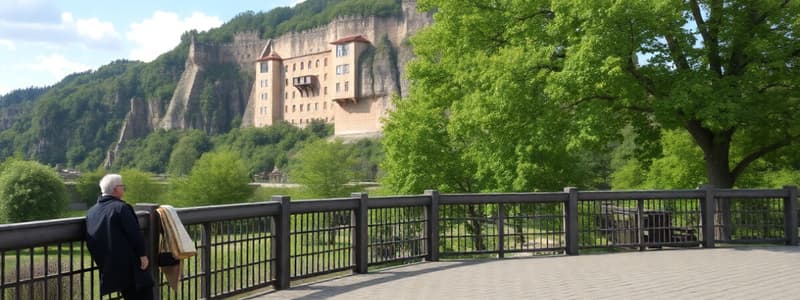Podcast
Questions and Answers
Which tense is most appropriate for describing an action that was in progress at a specific point in the past?
Which tense is most appropriate for describing an action that was in progress at a specific point in the past?
- Present Perfect
- Past Continuous (correct)
- Past Perfect
- Past Simple
Identify the sentence that correctly uses the Past Perfect tense.
Identify the sentence that correctly uses the Past Perfect tense.
- I am seeing the movie tomorrow.
- I had seen the movie before you recommended it. (correct)
- I saw the movie yesterday.
- I am going to see the movie.
The Past Simple tense is used to describe an action that was in progress at a specific time in the past.
The Past Simple tense is used to describe an action that was in progress at a specific time in the past.
False (B)
When I arrived, they __________ (eat) dinner, but they hadn't finished dessert.
When I arrived, they __________ (eat) dinner, but they hadn't finished dessert.
Match each sentence with its correct tense usage:
Match each sentence with its correct tense usage:
Which of the following sentences correctly uses the past perfect tense?
Which of the following sentences correctly uses the past perfect tense?
The sentence 'I was eating dinner when the phone rang' uses the past simple tense correctly to describe the interrupted action.
The sentence 'I was eating dinner when the phone rang' uses the past simple tense correctly to describe the interrupted action.
Provide a sentence that correctly uses the past perfect tense to describe two events, ensuring the order of events is clear.
Provide a sentence that correctly uses the past perfect tense to describe two events, ensuring the order of events is clear.
They __________ (play) football at 3 PM yesterday.
They __________ (play) football at 3 PM yesterday.
Match the following sentences with the tense that best describes them:
Match the following sentences with the tense that best describes them:
Which of the following sentences correctly combines the past continuous and past simple tenses to show an interrupted action?
Which of the following sentences correctly combines the past continuous and past simple tenses to show an interrupted action?
The past perfect tense is correctly used in the sentence: 'By the time I arrived at the party, everyone is already dancing.'
The past perfect tense is correctly used in the sentence: 'By the time I arrived at the party, everyone is already dancing.'
Create a sentence that uses the past perfect tense to indicate that one event was completed before another event in the past.
Create a sentence that uses the past perfect tense to indicate that one event was completed before another event in the past.
By the time we got there, they __________ (eat) dinner.
By the time we got there, they __________ (eat) dinner.
Match each verb tense with its primary function:
Match each verb tense with its primary function:
Which of the following sentences uses the past continuous tense correctly?
Which of the following sentences uses the past continuous tense correctly?
In the sentence 'I had finished my work before they arrive', the use of the past simple is correct.
In the sentence 'I had finished my work before they arrive', the use of the past simple is correct.
Explain how the past perfect tense is used to show the sequence of two past events.
Explain how the past perfect tense is used to show the sequence of two past events.
I __________ (not/see) snow before I moved to Canada.
I __________ (not/see) snow before I moved to Canada.
Match each example sentence with the correct tense:
Match each example sentence with the correct tense:
Which sentence demonstrates the correct use of past simple to describe a completed action with a specific time?
Which sentence demonstrates the correct use of past simple to describe a completed action with a specific time?
When describing a sequence of events in the past, it is incorrect to mix past simple and past perfect tenses.
When describing a sequence of events in the past, it is incorrect to mix past simple and past perfect tenses.
Explain the difference in usage between past simple and past continuous when describing actions in the past.
Explain the difference in usage between past simple and past continuous when describing actions in the past.
She __________ (study) all night.
She __________ (study) all night.
Match each sentence with the most suitable tense:
Match each sentence with the most suitable tense:
Which example correctly uses past continuous to set the scene or provide background information?
Which example correctly uses past continuous to set the scene or provide background information?
The sentence 'After I ate dinner, I had watched TV' correctly uses past perfect to show the order of events.
The sentence 'After I ate dinner, I had watched TV' correctly uses past perfect to show the order of events.
Describe a scenario where using the past perfect tense is essential to understanding the order of past events.
Describe a scenario where using the past perfect tense is essential to understanding the order of past events.
He __________ (not study) for the test, so he failed.
He __________ (not study) for the test, so he failed.
Match the function to the tense:
Match the function to the tense:
Choose the sentence that correctly combines past perfect and past simple to show order of events.
Choose the sentence that correctly combines past perfect and past simple to show order of events.
The primary function of the past continuous tense is to describe actions that have been completed at a specified time in the past.
The primary function of the past continuous tense is to describe actions that have been completed at a specified time in the past.
Provide an example of a sentence using past continuous to describe an action interrupted by another action in the past.
Provide an example of a sentence using past continuous to describe an action interrupted by another action in the past.
__________ (you/meet) him before the party?
__________ (you/meet) him before the party?
Match each example with the correct tense used:
Match each example with the correct tense used:
Which scenario best illustrates the use of past perfect to show that one past action preceded another?
Which scenario best illustrates the use of past perfect to show that one past action preceded another?
When describing a sequence of events in the past, only past simple should be used to maintain clarity.
When describing a sequence of events in the past, only past simple should be used to maintain clarity.
Describe how using past continuous with past simple helps paint a more detailed picture of a past event.
Describe how using past continuous with past simple helps paint a more detailed picture of a past event.
When I arrived, they __________ (still/eat), but they __________ (finish) the appetizers.
When I arrived, they __________ (still/eat), but they __________ (finish) the appetizers.
Consider the sentence: 'By the time the rescue team arrived, the hikers _______ a shelter out of branches and leaves.' Which verb tense correctly completes the sentence, emphasizing that the action of building the shelter was finished before the arrival?
Consider the sentence: 'By the time the rescue team arrived, the hikers _______ a shelter out of branches and leaves.' Which verb tense correctly completes the sentence, emphasizing that the action of building the shelter was finished before the arrival?
The past continuous tense is correctly used to describe a completed action at a specific time in the past.
The past continuous tense is correctly used to describe a completed action at a specific time in the past.
Provide a sentence that correctly uses the past perfect tense to explain the relationship between two past actions, explicitly showing which action occurred first.
Provide a sentence that correctly uses the past perfect tense to explain the relationship between two past actions, explicitly showing which action occurred first.
I ______ to the radio when the power suddenly went out.
I ______ to the radio when the power suddenly went out.
Match each sentence with the correct verb tense used:
Match each sentence with the correct verb tense used:
Flashcards
Past Simple
Past Simple
Expresses completed actions or habits in the past, with the time either specified or understood. Regular verbs add '-ed', while irregular verbs have unique forms.
Past Continuous
Past Continuous
Describes actions in progress at a specific time in the past, often interrupted by another action. Uses 'was/were' + verb-ing.
Past Perfect
Past Perfect
Describes an action completed before another action in the past. Uses 'had' + past participle.
Past Simple Use Case
Past Simple Use Case
Signup and view all the flashcards
Past Continuous Use Case
Past Continuous Use Case
Signup and view all the flashcards
Past Perfect Use Case
Past Perfect Use Case
Signup and view all the flashcards
Avoid Confusing Past Simple and Continuous
Avoid Confusing Past Simple and Continuous
Signup and view all the flashcards
Correct Past Perfect Formation
Correct Past Perfect Formation
Signup and view all the flashcards
Appropriate Past Perfect Use
Appropriate Past Perfect Use
Signup and view all the flashcards
Example of Past Simple
Example of Past Simple
Signup and view all the flashcards
Example of Past Continuous
Example of Past Continuous
Signup and view all the flashcards
Example of Past Continuous - Background
Example of Past Continuous - Background
Signup and view all the flashcards
Example of Past Perfect
Example of Past Perfect
Signup and view all the flashcards
Study Notes
- The past simple, past continuous, and past perfect are English verb tenses used to describe actions that happened in the past.
- They differ in how they portray the timing and completion of these actions.
Past Simple
- Used to express completed actions or habits in the past.
- The time of the action is either specified or understood.
- Often used with adverbs or phrases of time like "yesterday," "last week," "in 2010," etc.
- Formed by adding "-ed" to the base form of regular verbs (e.g., walked, played).
- Irregular verbs have unique past simple forms (e.g., go -> went, see -> saw).
- Example: I visited Paris last summer (completed action with a specified time).
- Example: She worked as a teacher for ten years (completed action over a period of time).
- Example: They watched a movie last night (completed action with specified time).
- Example: He didn't like the food (negative statement about a past state).
- Example: Did you go to the party? (question about a past action).
Past Continuous
- Used to describe actions in progress at a specific time in the past.
- Indicates that an action was ongoing when something else happened or at a particular point in time.
- Formed using "was/were" + the present participle (verb + "-ing").
- Example: I was watching TV when you called (action in progress interrupted by another action).
- Example: They were playing football at 3 PM yesterday (action in progress at a specific time).
- Example: She was studying all night (action in progress over a period of time).
- Example: It was raining when I left the house (background action or scene-setting).
- Example: He wasn't listening to me (negative statement about an action in progress).
- Example: Were you sleeping when I arrived? (question about an action in progress).
Past Perfect
- Used to describe an action that was completed before another action in the past.
- Indicates that one event happened before another, providing a sequence of past events.
- Formed using "had" + the past participle (the form used in the present perfect e.g. eaten, seen).
- Often used with time expressions such as "before," "after," "by the time," or "already."
- Example: I had finished my work before they arrived (the work was completed before their arrival).
- Example: She had never seen snow before she moved to Canada (the lack of experience happened before the move).
- Example: They had eaten dinner by the time we got there (the eating was completed before our arrival).
- Example: He hadn't studied for the test, so he failed (the lack of study occurred before the failure).
- Example: Had you met him before the party? (question about a completed action before a specific time).
Summary of Key Differences
- Past Simple: A completed action at a specific time in the past.
- Past Continuous: An action in progress at a specific time in the past or when another action occurred.
- Past Perfect: An action completed before another action in the past.
Usage Scenarios
- To describe a sequence of events: "I woke up, got dressed, and ate breakfast" (Past Simple).
- To describe an interrupted action: "I was walking down the street when I saw an accident" (Past Continuous interrupted by Past Simple).
- To provide background information: "It was raining heavily. I decided to stay inside" (Past Continuous providing context for Past Simple).
- To show the order of past events: "After I had eaten dinner, I watched TV" (Past Perfect showing the earlier action).
Common Mistakes to Avoid
- Confusing the Past Simple and Past Continuous: Use Past Simple for completed actions and Past Continuous for actions in progress.
- Incorrectly forming the Past Perfect: Remember to use "had" + the past participle.
- Misusing the Past Perfect: Only use it when you need to show that one past action was completed before another.
Using the Tenses Together
- Complex sentences often use a combination of these tenses to provide a clear narrative of past events.
- Example: "When I arrived (Past Simple), they were still eating (Past Continuous), but they had already finished (Past Perfect) the appetizers."
Studying That Suits You
Use AI to generate personalized quizzes and flashcards to suit your learning preferences.





